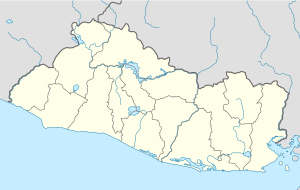La Libertad, La Libertad
| La Libertad | |
|---|---|
| Municipality | |
 |
|
| Location in El Salvador | |
| Coordinates: 13°29′N 89°19′W / 13.483°N 89.317°WCoordinates: 13°29′N 89°19′W / 13.483°N 89.317°W | |
| Country |
|
| Department | La Libertad |
| Elevation | 100 ft (30 m) |
| Population | |
| • Urban | 35,997 |
| • Metro | 45,007 |
La Libertad (Liberty) is a municipality in the La Libertad Department of El Salvador. It had a population of 35,997 inhabitants in 2007 according to the official census of that year. It is one of the main tourist attractions in the country.
In 1770 this area was referred to by Pedro Cortes, the Archbishop of Guatemala (1776–1779), as the "hacienda Tepeahua", one of the largest estates in the parish of San Jacinto. The region was known as Tepeahua, a name derived from a Nahuatl expression meaning "mountain of the oak trees", before the Congress of the Federal Republic of Central America authorized the name "Puerto de La Libertad" (Port of Freedom) on February 24, 1824. The national assembly chartered commercial trade on the Pacific coast in 1831, and the first steamboat arrived at La Libertad on June 7, 1857.
La Libertad was incorporated as a village by an Executive decree of July 19, 1858, which was approved by the Congress on February 11, 1859. This was done to relieve the community's excessive dependence on the town of Huizúcar, located at a considerable distance and connected by bad roads.
The town became part of the department of La Libertad on January 28, 1865, and by 1869 had a population of 266 inhabitants. On May 4, 1867, the Salvadoran government awarded the contract for construction of an iron pier, which opened on October 7, 1869. Prior to this, barges were unloaded by securing them with mooring lines. The Salvadoran government enfranchised La Libertad as a villa (town) on March 10, 1874, and as a ciudad (city) on 23 August 1957. The telegraph line between San Salvador and the port was inaugurated on April 27, 1870.
The municipality covers an area of 162 km² and its highest elevation is 10m above sea level. The local economy is based on agriculture and the service sector. The fiestas patronales (patron saint festivals) are celebrated in December in honor of the Immaculate Conception.
El Puerto de La Libertad is one of the most representative tourist destinations in El Salvador. The resort includes a boardwalk, restaurants and an amphitheater, while small seafood markets and craft shops are located at the wharf. Construction of the first phase of the work was inaugurated on January 6, 2006, and completed in early 2010.
Other beaches located in the municipality include Las Flores, San Diego, El Obispo, La Paz and El Majahual. Among the area's highlights is the Parque Nacional Walter Thilo Deininger (Walter Thilo Deininger National Park), situated on the Coastal Highway (CA-2) near Playa San Diego, going east from La Libertad towards the El Salvador International Airport. The Deiningers were the first German immigrants to settle in the La Libertad department. They established dairies, cattle ranches and coffee plantations.
...
Wikipedia

